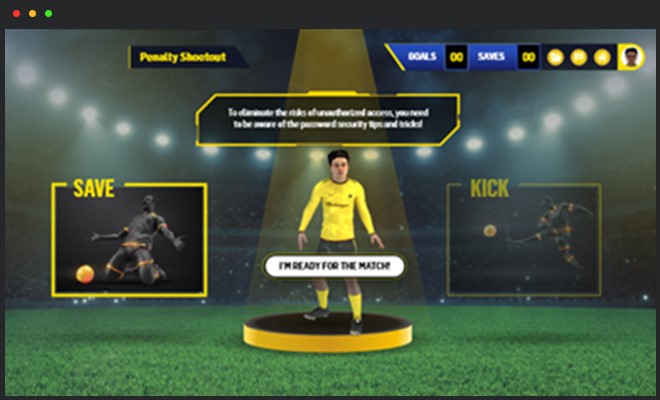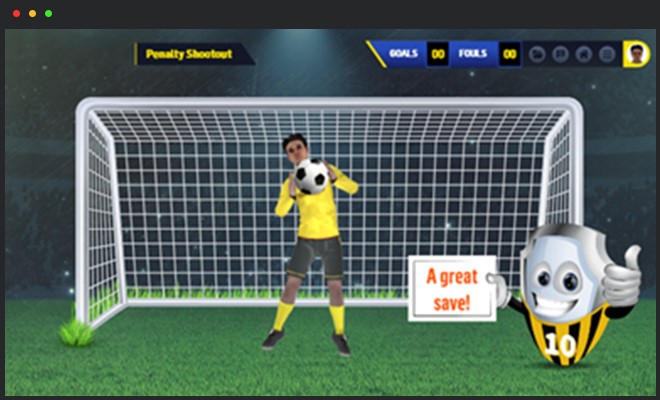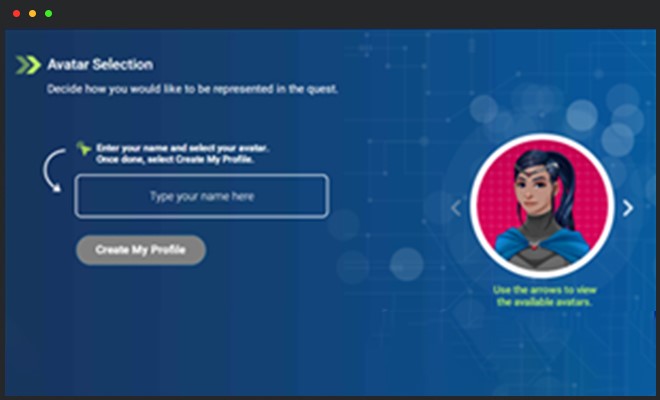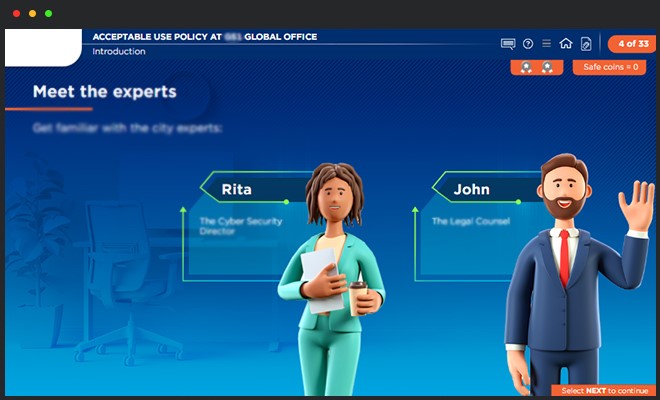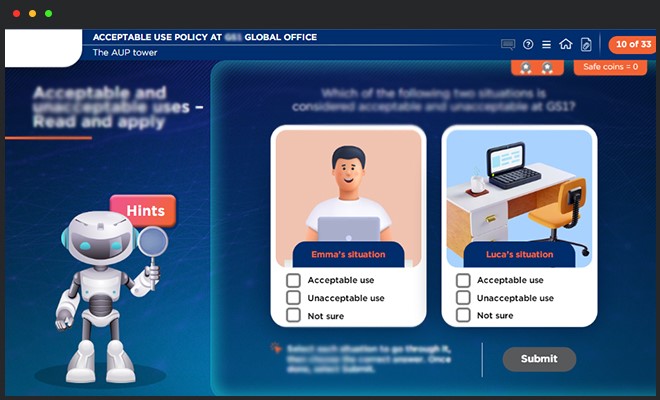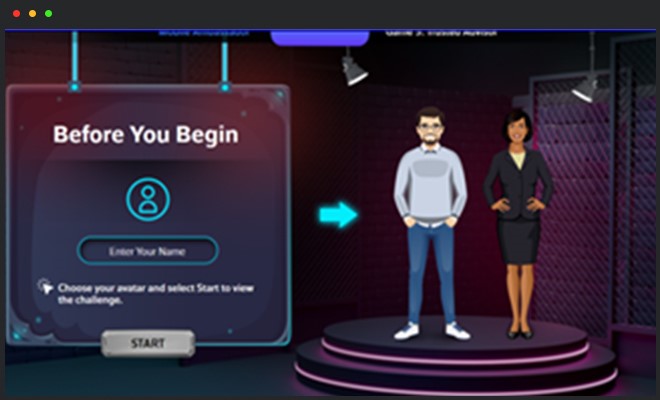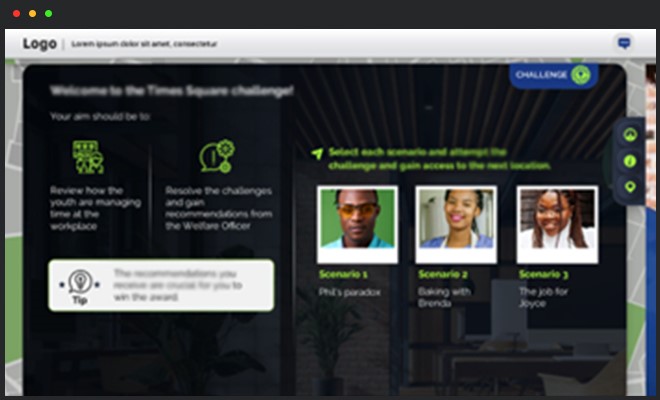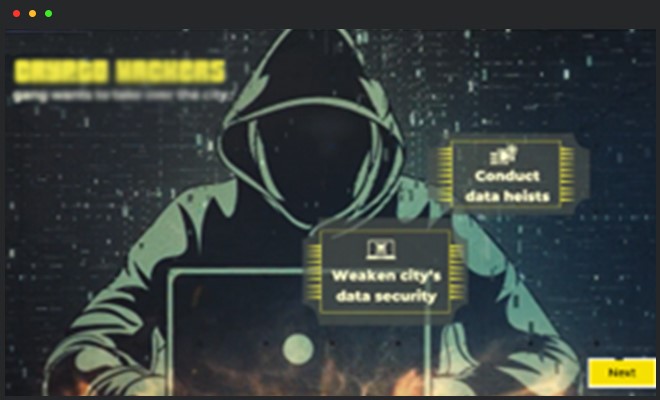HOME :: Gamification Strategies to Enhance Learning & Boost ROI
Gamification Strategies and Best Practices to Upskill Your Learners and Improve Business ROI
1
Introduction to Gamification
Gamification for learning (or, notably, serious learning) is all about using the principles and key elements of gaming to meet the required learning objectives. An efficient Gamification strategy offers higher completion rates as well as improved recall and retention. It can also be used to successfully help learners enhance the application of learning on the job and help them upskill. It integrates game mechanics into non-game environments, such as learning or business settings, to enhance user engagement.
Gamification capitalizes on human psychological predisposition and applying game-design thinking and elements to various aspects of life, making tasks more interactive and enjoyable. It taps into fundamental desires for recognition, achievement, competition, and collaboration, transforming routine tasks into more engaging and rewarding experiences.
2
The Psychology Behind Gamification
In workplaces, abundant non-work-related distractions heighten the risk of learner disengagement during conventional training courses. To counter this, Gamification injects interactivity, competition, and immediate feedback, amplifying engagement and relevance in skill-based learning contexts.
That’s why more L&D professionals are turning to game based and gamified learning to drive engagement.
- Gamification design is based on a learner-centric course design, which personalizes the content based on learner likes and preferences.
- Unlike the restrictive functional focus of traditional eLearning content, gaming content is typically tied to specific learning objectives, to which individual learners relate to.
- By appealing to core learner values, through game based situations, characters, and plots, learners more readily engage with game based learning.
- Elements of rewards and recognition in a game—badges, points, leaderboards—make learners feel appreciated and challenged.
Gamification also capitalizes on the cognitive and emotional aspects of learning by integrating game mechanics into L&D strategies. This approach is backed by several psychological theories and neuroscientific findings:
- Cognitive Evaluation Theory: Suggests that intrinsic motivators such as autonomy, mastery, and purpose enhance the quality of learning. Gamification naturally incorporates these elements, making eLearning intrinsically rewarding.
- Neuroscience and Dopamine Release: Achievements in games trigger dopamine release, a neurotransmitter associated with pleasure and learning, which reinforces continued engagement and information retention.
Gamification aligns with established educational theories in the context of L&D and eLearning:
- Constructivist Learning Theory: Proposes that learners construct knowledge through experiences. Gamification provides these interactive experiences.
- Experiential Learning: Encourages learners to learn through action, reflection, and experimentation, a process that is readily facilitated by gamified elements.
3
The Appeal of Gamification for Learners
For learners, Gamification helps enhance performance, productivity, and increases motivation to learn and level up. For L&D teams, a personalized, learner-centric experience helps tie learning objectives to gamified journeys that help measure the impact through KPIs. It drives employee engagement by making learning appealing to core learner values and makes learners feel appreciated and challenged. Gamified learning is human-focused and helps design learning experiences that prioritize human motivation over purely technical efficiency.
4
The Importance of Gamification in Learning
Gamification is the key to transforming learning environments into interactive and immersive experiences. By integrating elements like point scoring, competition, and rules of play, it addresses various learning styles and increases learner engagement. This strategy not only makes learning enjoyable, but it also increases retention rates and promotes the practical application of knowledge.
Gamification adds a hands-on component to learning, allowing learners to explore, solve issues, and see the real-world consequences. It effectively closes the gap between theoretical knowledge and real-world application, increasing the impact and significance of learning.
5
Benefits of Workplace Gamification
Gamification has revolutionized the L&D landscape, delivering a myriad of benefits not only to learners but also to the organizations behind their development. Here’s how Gamification creates a win-win situation for all involved:
For Learners:
- Increases Engagement and Motivation: Gamification transforms traditional learning content into interactive challenges, making the process more exciting and engaging.
- Encourages Active Participation: Interactive elements like quizzes and leaderboards prompt learners to take an active role in their learning journey.
- Fosters Achievement and Progress: The achievement system in gamification, through badges and awards, helps learners track their progress and feel accomplished.
- Enhances Critical Thinking: Game-based problem-solving scenarios cultivate analytical skills, preparing learners for real-life challenges.
- Boosts Confidence: Mastery of gamified tasks builds self-assurance in learners’ abilities to tackle complex subjects.
- Encourages Risk-taking: The low-stakes environment of Gamification encourages learners to explore and experiment without fear of failure.
- Personalizes Learning: Adaptive learning paths in Gamification cater to individual learner’s pace and style.
- Improves Memory Retention: The interactive and repetitive nature of games helps in better information recall.
For L&D Teams:
- Provides Measurable Data: Gamification systems offer analytics on learner engagement and success rates.
- Allows Real-time Adjustments: Immediate feedback from gamified activities enables quick course corrections to optimize learning outcomes.
- Encourages Peer Learning: Multiplayer aspects and discussion boards within gamified learning foster collaborative skills.
- Facilitates Behavior Analysis: Learner interaction with games provides insights into preferences and behaviors.
- Promotes Continuous Learning: The addictive nature of games can instill lifelong learning habit.
- Reduces Costs: Digital Gamification platforms can be more cost-effective than traditional in-person training.
- Streamlines Onboarding: Gamification makes the onboarding process faster and more enjoyable for new hires.
- Enhances L&D Reputation: Successful Gamification strategies can raise the profile and perceived value of L&D within an organization.
For the Business:
- Drives Competitive Advantage: Well-trained employees through Gamification become a strategic asset.
- Increases Employee Retention: Engaging learning experiences can result in higher job satisfaction.
- Improves Performance: Gamification aligns learning outcomes with practical job performance improvements.
- Enhances Adaptability: Employees trained through Gamification adapt more readily to change.
- Encourages Innovation: Gamified learning often involves creative problem-solving that can lead to innovative ideas.
- Leads to Better Customer Satisfaction: Skills gained through gamified learning translate to improved customer service.
Read More
- An Introduction to Gamification in Corporate Training
- Top Benefits Of Gamification In eLearning
- A Case Study on Enhancing Workforce Capabilities for Growth in a Leading Energy Organization
- Frequently Asked Questions (FAQs) on Gamification in Corporate Training
- How to Use Gamification to Promote Active Learning in the Changed Workplace Dynamics
6
Gamification vs. Game-Based Learning
Game-based learning (GBL) is the application of games to further learning objectives. The objectives can be accomplished by using tailor-made content – within a gaming environment. Alternately, third party game content can be leveraged for this purpose. The result is the same – to engage and motivate learners to acquire new skills, enhance existing ones, or modify unwanted behavior.
Gamification on the other hand uses game-like principles, within a non-gaming context (business, social settings, etc.), to drive behavioral change. Its primary focus is, therefore, on encouraging change (teaching new skills, modifying old behavior) through gaming mechanics.
7
Types of Gamification
We have created successful corporate trainings that have leveraged on Gamification techniques at several levels, including:
- Partial Gamification (to enhance traditional eLearning courses)
- Gamified aids to support ILT
- Gamified learning path
- Game-based learning
- Gamified portals
Our Next Gen Gamification techniques build up from the success of the current approaches. For instance:
- Instead of just having simple badges and leaderboards for each challenge, you can put the learner through a more complex narrative that can truly challenge him or her. The narrative is selected based on the content type, learner profile, and is aligned to the learning goals.
- Personalization holds the key to the learner’s attention, engagement, and motivation. You can use mobile apps for learning to offer a personalized learning path that is aligned to the learner’s goals. Thereby, it is relevant and more engaging.
- You can use a combination of learning strategies to gain higher impact. For instance, the usage of immersive techniques like a Virtual Reality (VR)-driven learning path that is gamified will surely multiply the impact and help you meet the learning goals.
You can opt for the following 7 Next Gen Gamification techniques for corporate training and achieve your mandates successfully:
- Longer-Term Gamification: Behavioral change requires the use of Gamification over a long period of time. You can use this longer-term learning path to have milestones over successive weeks/months/quarters.
- Periodic Checkpointing Of Learners’ Progress: Alongside, plan for a periodic assessment of learners’ progress (against the required outcomes) that can range from learning acquisition, its application, or a behavioral change.
- Multiply The Impact: To make the learning journey more engaging, you can add immersive approaches like Virtual Reality or wearable tech in your fold.
- Leverage On Microlearning-Based Gamification: Give the learners a “bite-sized” Gamification experience.
- Personalized Gamification: Offer personalized learning and gaming paths for learners.
- Social Media-Based Gamification: Let the learners collaborate with peers or experts and address challenges or solve problems, much the same way they need to in real life.
- Invest On Niche Gamification Portals: These can be designed to offer customized learning paths and elements of gamification, microlearning, and social learning.
8
Game Design Elements in Gamification
Gamification-related game design components include a range of methods and tools intended to improve learning efficacy and engagement, such as:
- Points, Badges, Leaderboards (PBLs): These components gamify learning by rewarding advancement, acknowledging accomplishments, and encouraging constructive competition among learners.
- Performance graphs: Graphical depictions that show how a person or group has improved over time, giving a clear picture of performance patterns and advancements.
- Meaningful stories: Narrative frameworks that contextualize learning objectives, making information more engaging and memorable for participants.
- Avatars and teammates: Virtual representations and collaborative groups that enhance social interaction and teamwork within gamified learning environments.
- Progress mechanics: Systems designed to outline clear paths to achieving learning goals, motivating learners with structured advancement opportunities.
- Narrative and characters: Story-driven elements that immerse learners in a cohesive narrative, enhancing engagement and connecting learning content to real-world scenarios.
- Player control and immediate feedback: Interactive features that empower learners by offering real-time responses and guidance, promoting active participation and continuous improvement.
- Collaborative problem solving: Activities that encourage teamwork and collective problem-solving skills, leveraging group dynamics to achieve shared learning objectives.
- Scaffolded learning and challenges: Gradually increasing levels of difficulty and structured tasks that support skill development, ensuring learners progress at their own pace.
- Mastery and leveling up: Systems that recognize skill mastery and encourage learners to advance to more harder levels or stages.
- Social connection: Fosters a sense of community and mutual support by providing opportunities for learners to engage, contribute, and share their achievements.
9
The Hierarchy of Game Elements
In general, anything that is used in the design of a game is often referred to as “a game element.” However, in most game design frameworks or theories, there are clearer categorizations of these elements. Werbach and Hunter (2012) organize those categories into a hierarchy of game elements as shown below. Game elements consist of mechanics, dynamics, and components.
- Game Mechanics: While there are many definitions of game mechanics in game studies, it can be summarized as the processes that “makes a game an exciting and engaging one.” By depending only on game components, user engagement would not last long. The MDA Framework by Hunicke et al. (2004) described game mechanics as “the various actions, behaviors, and control mechanisms afforded to the player within a game context.” In this sense, the most popular game mechanics are competition, challenge and win-state.
In the context of learning, Arnab et al. (2015) have done extensive work in mapping learning mechanics and game mechanics in what they called the LM-GM Model. It shows the linkages between game mechanics to the “processes and activities” that occur in teaching and learning.
- Game Dynamics: Game dynamics are the overarching elements that ultimately drive the users or players further. It’s the big picture. Different players would have different goals of playing a certain game and a good game would manipulate these goals by using appropriate dynamics. In essence, game dynamics define the patterns of how the game and the players will evolve over some time. The most popular game dynamics would be narrative (good and engaging storyline), progression and relationship.
Another way to examine game dynamics is by considering the Core Drives in the Octalysis model. As shown in the figure below, there are 8 core drives that are known to motivate users and these are often employed in gamification. The elements (components and mechanics) are shown at the side of each core drive. In Empowerment, for instance, boosters and feedback can be used to allow players to feel that they have gained certain power and freedom in the game.
- Game Components: Game components are the specific features that represent the intended mechanics and dynamics. These could cover common components like points, badges, and leaderboards. The components are seen as the building blocks for the game mechanics and dynamics to work accordingly. You can view game components as materials or tools (physical or virtual) that you have or chosen in order to make sure they can be used to “run” certain mechanics or dynamics.
10
Implementing Gamification
Here are 6 techniques that can take your Gamification experience notches higher. By implementing these strategies, you’ll unlock new levels of engagement in your learning journey in the workplace. Dive in and level up!
Progress and Achievement:
- Checkpoints for monitoring progress: Utilize checkpoints to control the overall flow and provide instant gratification.
- Progress bars: Design progress bars to encourage excitement and create interest to complete activities.
- Levels: Make different levels to portray gradual progression and make learners feel competent.
- Milestones: Integrate milestones in the learning path to showcase significant advancements and create new targets.
- Unlockable content: Introduce unlockable content to maximize the engagement rate and encourage learners to achieve desired outcomes.
Rewards and Incentives:
- Badges: Provide badges to show that the learner has mastered a certain topic or for their progress.
- Points: They work as a trigger for a learner to get involved whenever some reward points are at stake.
- Reward achievements: Award learners with certificates and diplomas that make them proud of their knowledge.
- Boosters: Provide boosters to help the learner to do something faster or enhance performance.
- Status points and exchangeable points: Use status points to rank learners and exchangeable points to act as currency for rewards.
- Mystery boxes: You can introduce mystery boxes that learners can open and find what’s inside! Was it a surprise? or was it a special few reward points?
Competition and Collaboration:
- Promote healthy competition: Encourage healthy rivalry by focusing on rewarding individuals for their improvement and progress rather than ranking high score.
- Encourage collaboration: Leverage group activities and quests to support team building and shared goals.
- Leaderboards: Show leaderboards to demonstrate the amount of progress and achievements, thus promoting a friendly rivalry.
- Group quests: Make team quests which requires them to work in collaboration to achieve a common goal.
Engagement and Interaction:
- Use curiosity and surprise: Use curiosity and surprise to maintain learners’ interest and encourage them to discover more.
- Gamified quizzes: Use gamified quizzes to test knowledge and provide interactive learning.
- Simulations: Use simulations to offer experiential learning in a safe, hands-on, virtual environment.
- Continuous play: Make learning as continuous as possible with no breaks or pauses.
- Avatars: Give learners the ability to customize their experience by designing their own avatars.
- Quests: Create clear, meaningful objectives and challenges for learners.
- Narrative and storytelling: Use narrative and storytelling techniques to create a world around the learning, making it more engaging and memorable.
Social and Community:
- Leverage social media and communities: Allow social media and communities to play a key role in enabling learners to connect, collaborate, and share knowledge with each other.
- Brag buttons: Implement brag buttons to encourage learners to share their achievements and milestones with others.
- Tout flags: Create a sense of community in the learner journey by inspiring learners to appreciate and encourage each other.
Game Mechanics:
- Personalization: Make the learning experience personal to individual preferences and motivations.
- Scarcity and exclusivity: Offer limited-time deals or exclusive rewards to create scarcity and exclusiveness.
- Fear of Missing Out (FOMO): Use FOMO to foster engagement and encourage participation.
- Irreversible actions: Instill a sense of consequence and accountability by implementing irreversible actions.
- Loss aversion: Stress possible missed opportunities or highlight potential losses.
- Time constraints: Incorporate time limits to spur action and create a sense of urgency.
- Feedback mechanisms: Use feedback systems to give advice in good time to enable learners to know of their progress and whether they have performed well.
11
Best Practices for Implementing Gamification in Training
To ensure effective Gamification in training, consider these best practices:
- Align with Learning Objectives: Ensure Gamification elements support the training’s educational goals.
- Balance Fun and Learning: Mix engaging game elements with serious learning content.
- Customize to Audience: Tailor Gamification elements to the preferences and skill levels of your learners.
- Provide Meaningful Rewards: Offer rewards that are valuable and relevant to the learners.
- Gather Feedback: Regularly collect feedback to refine and improve the gamified training experience.
- Track Progress: Implement mechanisms to monitor learner progress and adjust strategies as needed.
12
Challenges of Gamification
Gamification can considerably help corporate training, but it must be used appropriately.
- Resource Intensive: Developing a gamified learning environment can require significant time, expertise, and financial resources.
- Overemphasis on Rewards: Excessive focus on rewards and points can overshadow the actual learning objectives.
- One-Size-Fits-All Approach Risk: Gamification might not suit every learner’s style or every type of training content.
- Potential for Reduced Seriousness: If not balanced well, Gamification might lead to a perception of training as less serious or important.
- Difficulty in Measuring Effectiveness: Quantifying the impact of gamified elements on learning outcomes can be challenging.
Read More
- 7 Gamification Techniques For Corporate Training That Work
- Gamification Design Techniques to Engage and Energize Your Learners
- How to Drive Learner Engagement and Performance Through Gamification
- Gamification Use Case: How To Offset Employee Disengagement With A Gamified Learning Portal Approach
- Go Beyond Badges And Leaderboards: 5 Examples Of Gamification In Corporate Training
13
Examples of Gamification in Learning
The following sections showcase examples of Gamification in Learning, highlighting how creative strategies improve engagement and effectiveness within learning environments:
Example 1: FIFA Inspired Gamified Solution Driving Compliance Training
The Need: A global beverage and brewing company wanted to raise awareness of digital security risks and empower its employees to handle the ever-growing cyber adversities.
Our Solution: A Security & Compliance Awareness Campaign was launched. Capitalizing on the FIFA World Cup fever, we collaborated with the client team to create 3 football themed mini games to raise user awareness of digital security risks and empowering colleagues to handle the ever-growing cyber adversities in a fun and interactive manner.
Impact:
- A 62% growth was reported in learner engagement.
- An 84% growth was noted in unique users.
- An average rating of 9 out of 10 was received on the overall learning experience.
The solution was awarded two Brandon Hall Awards:
- Best Advanced in Learning Management Technology for Compliance Training
- Best Advance in Compliance Training
Example 2: Driving Policy Compliance for a Global Organization
The Need: A multinational company sought an engaging training solution to ensure employees understood and complied with a new data protection and IT asset usage policy.
Solution: An interactive eLearning program using gamification, modern design, and real-life scenarios, delivered as a city-based game.
Impact:
- 133 employees completed the course rapidly, indicating high engagement.
- Positive learner feedback on the engaging and enjoyable format.
- Increased attention to IT asset use and fewer security incidents.
Example 3: Gamification Product Training
The Need: A US-based telecommunications conglomerate looked to train its salespeople in a specific product line to boost its sales.
Solution: A game-based sales training program with a set of modules was designed. As part of the game, learners were put on a mission to become the "Product Line Brand Ambassador." The mission comprised 5 stages (or mini games), with specific tasks and badges to win at each stage. Learners were required to complete each mini game successfully to win the challenge.
Impact: Improvement was noted in the product sale rate (Nov’21 – March’22 vs. Nov’22 – March’23):
- 0-30 Days: increased by 0.12%
- 91-120 Days: increased by 0.20%
- Overall, all tenure performance: increased by 0.21% (increased by 181%)
The solution was awarded 4 Brandon Hall Awards 2023—1 gold and 3 silvers in the following categories:
- Best Advance in Custom Content
- Best Use of Games or Simulations for Learning
- Best Program for Sales Training and Performance
- Best Unique or Innovative Sales Training Program
Example 4: Gamified Youth Employability Training
The Need: A non-profit in Kenya aimed to empower youth with essential life skills to boost employability and social standing. The existing training program, though well-intentioned, needed a more engaging and relevant approach to better connect with the audience, primarily from lower economic backgrounds, to maximize its impact.
Solution: A multi-level game Lead the Change was designed. Learners played the game to increase their awareness of life skills required to enhance employability. They were put on a mission to achieve the ‘Counsellor of the Year’ award. Learners gained bonus points, applied learning in real-life scenarios, and received award recommendations.
We partnered closely with the client to understand the background of the audience and the intended outcome. Our learning consultants created a customized learning journey that involved the learner persona as the primary protagonist to drive the learning. A story-driven, fully gamified learning was created with relatable characters to bring in connect, relatability, and engagement.
Impact: This shift from a traditional learning model to a learner-centric instructional approach saw significant results:
- Also, over 75,000 youth secured livelihood opportunities with a successful placement rate of over 80%.
- An impressive 84% completion rate from different branches across the country. A record high considering 2-3% completion earlier on similar programs.
- A notable 92% of learners felt the eLearning model was good, citing its flexibility in terms of time and pace, while emphasizing its relatability.
The solution was awarded Best Advance in Social Impact Innovation and Best Advance in Competencies and Skill Development by Brandon Hall Group.
Example 5: Theme-based Gamified Solution Driving IT Security Training
The Need: A global beverage and brewing company wanted to raise awareness of digital security risks and empower its employees to handle the ever-growing cyber adversities.
Our Solution: As part of Security & Compliance Awareness Campaign, a mission-driven, theme-based gamified course called “Cyber Grand Threat” was launched. By blending scenario-based challenges with engaging game elements, the course immersed learners in real-world situations that enhanced their understanding of security risks. Designed to encourage the application of key concepts, it equipped learners with practical skills to navigate and respond effectively to cyber threats.
Impact:
- 70% increase in engagement was noted from gamified elements that captivated learners.
- 70% of learners reported increased confidence in handling cyber threats.
- 60% faster response times were observed in practical applications of learned skills.
The power of Gamification in eLearning that is aligned to learning outcomes is clearly evident in these 5 examples.
14
Emerging Trends in Gamification
As digital learning transforms, Gamification is pushing boundaries with innovative techniques that boost motivation and retention. Here are a few trends shaping the future of gamified learning:
1. Immersive Learning Environments
In 2025, we’re witnessing a deeper immersion of gamified elements within learning environments. Virtual Reality (VR) and Augmented Reality (AR) are increasingly integrated into training modules, creating more realistic and engaging scenarios for learners.
Tips:
- Utilize VR to simulate complex tasks or environments for safe, hands-on practice.
- Implement AR for interactive job aids or to enhance real-world training with overlaid information.
- Design immersive storytelling experiences that draw learners into scenarios that mimic real-life challenges.
2. AI-Driven Personalization
Artificial Intelligence (AI) is enhancing Gamification with personalized learning experiences. AI can analyze a learner’s interactions and performance, tailoring the gamified content to suit individual learning styles and preferences.
Tips:
- Use AI to offer dynamic content recommendations based on learner behavior.
- Implement AI coaches or chatbots that provide personalized tips and encouragement.
- Analyze data collected by AI to continually improve the relevance and impact of gamified learning activities.
3. AI-Powered Gamification
AI-powered Gamification is revolutionizing learning with highly personalized experiences that respond to the unique needs of each learner. Through the analysis of performance and behavioral data with AI, gamified learning is dynamically optimized to keep learners engaged, motivated, and suitably challenged.
Tips:
- Dynamic Personalization: Use AI to adapt content and challenges to learner preferences and performance.
- Real-Time Adaptation: Create adaptive learning paths which adjust challenges and provide rewards as per the progress of learner.
- Immersive Simulations: Use AI with VR/AR to develop interactive and realistic simulations becoming a source of hands-on learning.
- Instant Feedback & Rewards: Apply immediate personalized feedback and rewards to boost motivation.
- Continuous Improvement: Utilize AI capabilities to monitor progress and adapt Gamification for continuous learner engagement.
4. Gamification for a Multigenerational Workforce
As today’s workforce is multi-generational, Gamification is evolving to engage employees across all age groups, from Baby Boomers through to Gen Z. Well-designed gamified learning experiences built with a range of learner profiles in mind will increase engagement and develop skills throughout the whole organization.
Tips:
- Personalized Experiences: Tailor challenges to different learning styles (e.g., points, narratives, microlearning).
- Multi-Platform Access: Ensure content is accessible on various devices to suit all tech comfort levels.
- Varying Challenge Levels: Design challenges with different complexity levels to engage all generations.
- Inclusive Rewards: Offer incentives that are valuable for both the younger and older generations (recognition, promotion).
- Collaborative Learning: Encourage team-based Gamification to promote cross-generational knowledge sharing.
5. Focus on Soft Skills Development
Gamification is increasingly used to develop soft skills such as leadership, communication, and empathy. Scenario-based gaming allows learners to practice these skills in a controlled, risk-free environment.
Tips:
- Design role-play simulations where learners can practice negotiation, conflict resolution, and team leadership.
- Use branching scenarios to let learners explore different outcomes based on their choices.
- Provide reflective learning opportunities by incorporating feedback loops into the Gamification strategy.
But there are many more! Be sure to check out our Read More section for additional insights.
Read More:
- Gamification Trends in 2025 – Packed with Tips and Ideas You Can Use
- Power Triad – Using mLearning, Microlearning, and Gamification to Create Immersive Learning Experiences
- How Personalized Gamification Can Increase Learner Engagement
- How Can You Combine Mobile Learning And Gamification To Create High Impact Training?
- Gamification And Microlearning: A Dynamite Combination
- 6 Killer Examples of Gamification in eLearning (Updated in 2024)
- How To Use Gamification To Enhance Compliance Training – Featuring 4 Examples
- How to Improve New Hire Integration and Engagement with Onboarding Gamification – Featuring 6 Examples
- 7 Proven Benefits of Sales Gamification To Boost Sales
- Gamification In Sales: Leaderboard Best Practices that Power Up Employee Engagement
15
Key Takeaways
Gamification is a strategic technique for improving learning outcomes, motivation, and engagement in learning settings. It goes beyond just adding entertaining aspects. Businesses can employ gaming elements such as points, badges, and leaderboards to transform training into interactive experiences that appeal to learners’ innate motivations. Furthermore, Gamification promotes skill development and ongoing improvement, making it a valuable tool in modern L&D methods.
